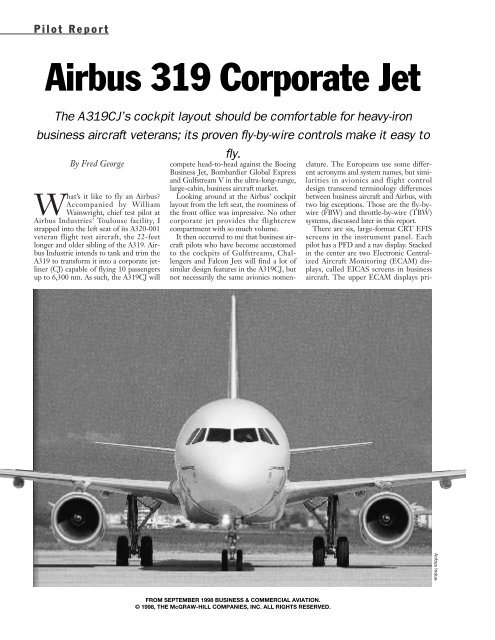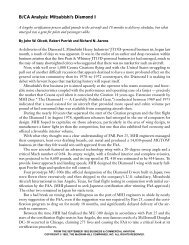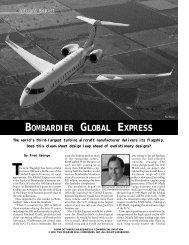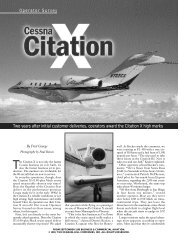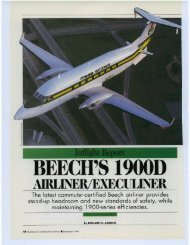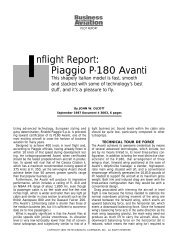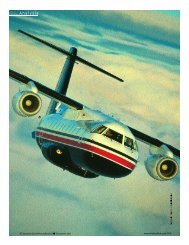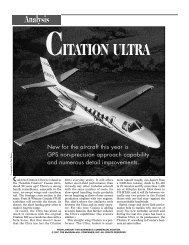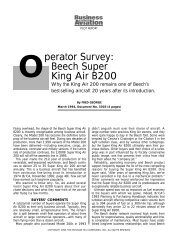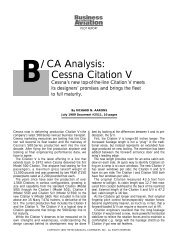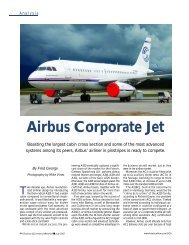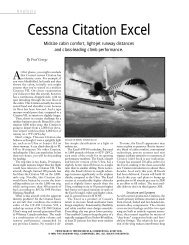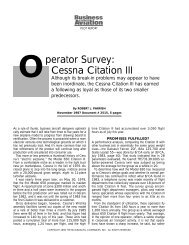Airbus 319 Corporate Jet
Airbus 319 Corporate Jet
Airbus 319 Corporate Jet
Create successful ePaper yourself
Turn your PDF publications into a flip-book with our unique Google optimized e-Paper software.
Pilot Report<br />
<strong>Airbus</strong> <strong>319</strong> <strong>Corporate</strong> <strong>Jet</strong><br />
The A<strong>319</strong>CJ’s cockpit layout should be comfortable for heavy-iron<br />
business aircraft veterans; its proven fly-by-wire controls make it easy to<br />
fly.<br />
By Fred George<br />
What’s it like to fly an <strong>Airbus</strong>?<br />
Accompanied by William<br />
Wainwright, chief test pilot at<br />
<strong>Airbus</strong> Industries’ Toulouse facility, I<br />
strapped into the left seat of its A320-001<br />
veteran flight test aircraft, the 22-feet<br />
longer and older sibling of the A<strong>319</strong>. <strong>Airbus</strong><br />
Industrie intends to tank and trim the<br />
A<strong>319</strong> to transform it into a corporate jetliner<br />
(CJ) capable of flying 10 passengers<br />
up to 6,300 nm. As such, the A<strong>319</strong>CJ will<br />
compete head-to-head against the Boeing<br />
Business <strong>Jet</strong>, Bombardier Global Express<br />
and Gulfstream V in the ultra-long-range,<br />
large-cabin, business aircraft market.<br />
Looking around at the <strong>Airbus</strong>’ cockpit<br />
layout from the left seat, the roominess of<br />
the front office was impressive. No other<br />
corporate jet provides the flightcrew<br />
compartment with so much volume.<br />
It then occurred to me that business aircraft<br />
pilots who have become accustomed<br />
to the cockpits of Gulfstreams, Challengers<br />
and Falcon <strong>Jet</strong>s will find a lot of<br />
similar design features in the A<strong>319</strong>CJ, but<br />
not necessarily the same avionics nomenclature.<br />
The Europeans use some different<br />
acronyms and system names, but similarities<br />
in avionics and flight control<br />
design transcend terminology differences<br />
between business aircraft and <strong>Airbus</strong>, with<br />
two big exceptions. Those are the fly-bywire<br />
(FBW) and throttle-by-wire (TBW)<br />
systems, discussed later in this report.<br />
There are six, large-format CRT EFIS<br />
screens in the instrument panel. Each<br />
pilot has a PFD and a nav display. Stacked<br />
in the center are two Electronic Centralized<br />
Aircraft Monitoring (ECAM) displays,<br />
called EICAS screens in business<br />
aircraft. The upper ECAM displays pri-<br />
<strong>Airbus</strong> Indus-<br />
FROM SEPTEMBER 1998 BUSINESS & COMMERCIAL AVIATION.<br />
© 1998, THE McGRAW-HILL COMPANIES, INC. ALL RIGHTS RESERVED.
Pilot Report<br />
Top right: No knob-ology confusion here. Each<br />
glareshield control panel knob has a distinctive<br />
feel plus an adjacent display. The baro set knob,<br />
for example, has a baro readout just above it.<br />
Bottom left: It takes very little time to become<br />
comfortable with the side stick controller because<br />
of its appropriate heft and control feel.<br />
Bottom center: You’re in control. Push up the<br />
throttles to the stops and you’ll get maximum<br />
thrust—regardless of autothrottle mode. Bottom<br />
right: The throttle quandrant is quite conventional,<br />
with one exception. The autothrottles don’t<br />
back-drive the levers for tactile feedback.<br />
Fred George<br />
mary engine data, flap/slat configuration<br />
and fuel quantity status. The lower screen<br />
displays individual system synoptics, plus<br />
secondary engine and cabin environment<br />
data.<br />
The lower ECAM is context sensitive,<br />
if you’ll allow us to borrow the computer<br />
industry term. For example, if a system<br />
malfunction occurs, the appropriate synoptic<br />
display comes into view, along with<br />
the abnormal/emergency procedures<br />
checklist. Each item on the checklist disappears<br />
from view when the appropriate<br />
action has been taken. However, it should<br />
be noted that other action items on the<br />
pocket checklist, albeit lower priority<br />
ones, also must be completed.<br />
Directly below the glareshield, there is<br />
the familiar flight guidance control panel,<br />
plus left- and right-side EFIS control<br />
panels and reversion controls for the sidestick<br />
controllers. As shown in the accompanying<br />
photograph, all these controls<br />
have displays that are directly adjacent to<br />
the switch, knob or button that controls<br />
the associated function. For example, the<br />
baro set display window is just above your<br />
fingers when you adjust the altimeter<br />
baro set knob. It’s also displayed next to<br />
the altitude scale on the PFD. The individual<br />
knobs for different functions also<br />
have a distinctive tactile feel, thereby<br />
helping to eliminate confusion.<br />
The overhead panel reflects the quiet,<br />
dark design philosophy of current generation<br />
business aircraft. The airframe systems,<br />
exterior light switches and engine<br />
controls are intuitive. For example, to<br />
start an engine once the APU is running,<br />
the pilot just presses fuel pump annunciator<br />
switches to make the lights go out,<br />
then goes down to the console to turn the<br />
start knob to start and move the engine<br />
master switches to run, one at a time.<br />
The FADECs handle the start chores, the<br />
generators automatically come on line.<br />
The <strong>Airbus</strong>’ highly automated systems<br />
slash the length of checklists. Also located<br />
on the console are integrated radio management<br />
panels that are virtually identical<br />
in function to radio management units in<br />
business aircraft, along with Honeywell<br />
FMS multi-function CDUs, the conventional<br />
left-side speed brake control and<br />
right-side flap/slat control.<br />
What’s Missing From This Cockpit?<br />
It’s the control yoke, along with its clumsy<br />
column that bumps your knees and<br />
blocks the view of the instrument panel.<br />
Pilots strap into the seats of an <strong>Airbus</strong> as<br />
comfortably as they settle into office<br />
chairs. A tray below the instrument panel<br />
may be pulled out, providing a flat table<br />
surface to hold a flight plan, navigation<br />
chart or procedures manual.<br />
A FBW side-stick controller replaces<br />
the yoke. This is anything but a jittery<br />
PC joystick. It has the heft and feel of a<br />
FROM SEPTEMBER 1998 BUSINESS & COMMERCIAL AVIATION.<br />
© 1998, THE McGRAW-HILL COMPANIES, INC. ALL RIGHTS RESERVED.
Fred George<br />
control stick handgrip in a fighter. <strong>Airbus</strong><br />
added enough artificial control force to<br />
the side stick to make it appropriate to a<br />
jetliner.<br />
The FBW system has four basic modes:<br />
ground, takeoff, flight and landing. It also<br />
has envelope protection to keep you from<br />
overstressing the aircraft or inadvertently<br />
stalling. Ground mode gives the pilot direct<br />
control over the flight control surfaces.<br />
During takeoff, the pilot still has<br />
direct control, but envelope protection is<br />
added to prevent inadvertent stall.<br />
The flight mode, used for climb, cruise<br />
Seven FBW computers provide plenty of redundancy,<br />
plus MMEL one-box-inop dispatch flexibility.<br />
A decade ago, the airlines suffered through all<br />
the growing pains of new technology. FBW now is<br />
fully mature, according to airlines we contacted.<br />
Bumps and thermals don’t upset the <strong>Airbus</strong>. The<br />
FBW system, similar to the control wheel steering<br />
mode of an autopilot, let’s you set the pitch<br />
and roll attitude. Configuration changes don’t<br />
cause pitch trim changes, either.<br />
and descent, allows the pilot to control<br />
vertical load changes in the pitch axis and<br />
roll rate changes in the roll axis. Let go of<br />
the stick and the pitch and roll attitudes<br />
remain fixed, within the flight protection<br />
envelope.<br />
When the aircraft’s radio altimeters<br />
sense that the aircraft is 50 feet above the<br />
ground and configured for landing, the<br />
FBW system makes the transition to the<br />
landing mode. The FBW system slowly<br />
rolls in two degrees of nosedown pitch<br />
trim to provide a natural feel during the<br />
landing flare and provides direct control<br />
of the primary flight control surfaces with<br />
stall protection.<br />
Admittedly, this all sounds complex.<br />
However, it works well and feels natural,<br />
from what I experienced during my brief<br />
demonstration flights.<br />
Some senior airline pilots have had initial<br />
reservations about the FBW system.<br />
Without feedback from the flight controls<br />
to the side stick controller, one pilot<br />
cannot directly monitor the control inputs<br />
of the other pilot, as the crew might<br />
in an aircraft with conventional controls.<br />
The pilots have complained about the<br />
lack of a mechanical interconnect between<br />
the side stick controllers for that<br />
reason.<br />
The other noticeable missing item is a<br />
servo-driven throttle system that would<br />
move the throttle in response to autothrottle<br />
commands, thereby providing<br />
tactile feedback of computer commands<br />
to the engines. The FADEC controlled<br />
engines have TBW controls with detents<br />
in the throttle quadrant for max climb<br />
and max continuous (flex) thrust. As with<br />
FADEC-equipped business aircraft, there<br />
are no mechanical connections between<br />
the throttles and the engines, only electronic<br />
links. But business aircraft have<br />
servo-driven throttles to provide tactile<br />
feel of authotrottle functions.<br />
<strong>Airbus</strong> claims that adding a servo-driven<br />
throttle would have increased throttle<br />
rigging chores, decreased reliability and<br />
increased overall operating cost.<br />
Some pilots have criticized the nonmoving<br />
autothrottle system for taking<br />
away their ability to monitor computercontrolled<br />
thrust changes. One senior airline<br />
captain told B/CA that more junior<br />
pilots may not be aware of subtle thrust<br />
changes because they have yet to acquire<br />
a feel for the airplane. Similar to their experience<br />
with the side stick controllers,<br />
senior pilots said they missed being able<br />
to monitor directly the other pilot’s control<br />
inputs because of the reliance upon<br />
automated systems.<br />
I found the TBW control to be similar<br />
to an automatic transmission gear selector.<br />
With the throttles in the max continuous<br />
or climb detent, the autothrottle system<br />
manages thrust changes, but the pilot can<br />
override the system when needed.<br />
If you need maximum thrust for a goaround<br />
or evasive maneuver during an<br />
approach, for example, just slam the<br />
throttles forward to the stops and you get<br />
maximum available thrust immediately,<br />
regardless of autothrottle function. Conversely,<br />
if you want less thrust than that<br />
commanded by the autothrottles, you can<br />
pull the throttles back out of the climb or<br />
flex detent and into the manual control<br />
range for less thrust. At the touch of a<br />
button, the pilot can disconnect the autothrottles<br />
altogether and regain full<br />
command authority over the engines.<br />
(For more information on <strong>Airbus</strong> flyby-wire<br />
and throttle-by-wire controls, see<br />
“Understanding <strong>Airbus</strong> Automation,”<br />
October 1997, page 52.)<br />
Flying the <strong>Airbus</strong><br />
I had an opportunity to briefly fly the<br />
A320 in Toulouse with Wainwright for<br />
low altitude work and then the A<strong>319</strong> with<br />
Patrick Baudry in Hamburg at typical<br />
cruise altitudes. The two aircraft have virtually<br />
identical flying characteristics, thus<br />
I’ve combined my impressions of flying<br />
both aircraft for this report.<br />
At its maximum takeoff weight of<br />
166,400 pounds, including 72,000 pounds<br />
of fuel, the A<strong>319</strong>CJ will have about the<br />
same thrust-to-weight ratio as its three<br />
main competitors. However, on the day I<br />
flew A320-001, we had only seven people<br />
on board and 22,000 pounds of fuel, resulting<br />
in a takeoff weight of 134,000<br />
pounds, about 81 percent of the<br />
A<strong>319</strong>CJ’s MTOW. The maximum en-<br />
Captain Patrick Baudry demonstrates how to<br />
gain access to an equipment bay.<br />
FROM SEPTEMBER 1998 BUSINESS & COMMERCIAL AVIATION.<br />
© 1998, THE McGRAW-HILL COMPANIES, INC. ALL RIGHTS RESERVED.
Pilot Report<br />
gine output, commanded by<br />
each FADEC, was adjusted<br />
to 27,000 pounds of thrust<br />
to simulate the A<strong>319</strong>CJ’s<br />
maximum takeoff thrust<br />
output, resulting in a<br />
thrust-to-weight ratio of a<br />
Learjet 60.<br />
Taxiing the A320 is easy.<br />
Cockpit visibility is superb,<br />
the steer-by-wire control<br />
(SBW) is smooth and precise.<br />
The brake-by-wire system<br />
(BBW), which uses<br />
carbon brakes, has excellent<br />
feel. The AFM takeoff computations<br />
called for 0.3<br />
units of nosedown pitch<br />
trim, but failing to set the<br />
proper pitch trim isn’t critical.<br />
With the fly-by-wire<br />
controls, any pitch trim setting<br />
in the green arc is acceptable,<br />
but it will result in<br />
heavier- or lighter-than-optimum<br />
stick control force<br />
feel at rotation because the<br />
FBW system is operating in<br />
the direct law mode.<br />
Our flaps/slats position 2<br />
configuration corresponded<br />
to flaps 15 degrees and slats 22 degrees.<br />
Actually, memorizing deflection numbers<br />
is unnecessary. The crew only has to<br />
know which of five flap/slat presets is appropriate<br />
to the phase of flight. ECAM<br />
graphics and symbol color cues tell the<br />
crew when the flaps and slats are in the<br />
correct position.<br />
The overall cockpit design de-emphasizes<br />
rote memorization of numbers and<br />
acronyms in favor of color cues and synoptic<br />
graphics. Smart redlines and stall<br />
speed margin cues on the airspeed scale<br />
help keep you in a safe operating envelope<br />
for each flap/slat configuration.<br />
<strong>Airbus</strong> engineers oppose automatic V-<br />
speed calculations by the FMS. They say<br />
they want to keep the pilot in the loop. In<br />
truth, past generations of the Honeywell<br />
FMS may not have had enough memory<br />
to support V-speed calculations and other<br />
performance management functions. Our<br />
manually computed takeoff V-speeds<br />
were 146 KIAS for V1 and VR, and 147<br />
KIAS for V2, which we plugged into the<br />
FMS CDU to set the airspeed bugs on<br />
the PFD.<br />
When cleared for takeoff on the roll, I<br />
pushed up the thrust levers to an indicated<br />
50 percent N1 thrust lever position<br />
(TLP) on the ECAM to allow the<br />
CFM56 engines to accelerate symmetrically.<br />
After about five seconds, both engines<br />
were up to speed. I then pushed up<br />
The A<strong>319</strong>CJ’s high stance provides plenty of ground clearance for the engines,<br />
but most every service task requires a ladder or another form of lift.<br />
the thrust levers to the forward stop in<br />
the quadrant to select maximum thrust.<br />
There was no doubt about having selected<br />
full throttle. A large, green TOGA<br />
(take off/go around) annunciator on the<br />
PFD confirmed the commanded thrust<br />
setting, along with the matching TLP/N1<br />
rpm indications on the ECAM. The acceleration<br />
was impressive, considering the<br />
67-ton mass of the A320.<br />
For most takeoffs on adequately long<br />
runways, pilots probably will push up the<br />
levers only to the second, or max continuous,<br />
flex detent. This position allows the<br />
FMS and autothrust system to set a reduced,<br />
or flex, takeoff thrust level to reduce<br />
engine wear.<br />
Wainwright called V1 and rotation at<br />
146 KIAS. I initially pulled back too gently<br />
on the side stick controller and the aircraft<br />
began to rotate at too slow a rate. I<br />
moderately increased the pressure to produce<br />
a more normal rotation rate until<br />
the pitch had increased to 18 degrees. I<br />
let go. The pitch attitude remained glued<br />
at 18 degrees as the aircraft accelerated.<br />
At 1,500 feet agl, a flashing, amber<br />
THR CLB (thrust climb) annunciation in<br />
the PFD cued us that it was safe to reduce<br />
thrust to the max continuous, or flex, detent.<br />
This automatically engaged the autothrust<br />
system in the maximum climb<br />
thrust mode. The amber, flashing THR<br />
CLB annunciation was replaced by a<br />
FROM SEPTEMBER 1998 BUSINESS & COMMERCIAL AVIATION.<br />
© 1998, THE McGRAW-HILL COMPANIES, INC. ALL RIGHTS RESERVED.<br />
Fred George<br />
steady, green THR annunciation.<br />
This told us that the autothrust<br />
system had commanded<br />
maximum available climb thrust.<br />
As we accelerated and cleaned<br />
up landing gear, flaps and slats,<br />
it was readily apparent that the<br />
FBW normal control law eliminates<br />
all the pitch transients and<br />
trim feel changes associated<br />
with speed and configuration<br />
changes. Indeed, this quasi control-wheel-steering<br />
function<br />
produced a lack of reaction in<br />
pitch trim feel that was almost<br />
uncanny. It didn’t take long,<br />
though, before I became accustomed<br />
to the lack of pitch<br />
changes. The <strong>Airbus</strong> philosophy<br />
seems to be, “just point and go.”<br />
Similarly, the pilot doesn’t<br />
need to make bank angle corrections<br />
in response to thermals,<br />
bumps and turbulence. The<br />
FBW system maintains the roll<br />
attitude commanded by the<br />
pilot. Stick inputs only are needed<br />
to change bank angle for a<br />
turn. Later, from the back of the<br />
cabin, I watched as the FBW<br />
system made the ailerons dance<br />
in response to the low altitude thermals<br />
near Toulouse. The passengers, as well as<br />
the pilots, are unaware of the automatic<br />
roll rate damping that produces a more<br />
comfortable ride. Turbulence still can<br />
produce up and down movements, but not<br />
the pitch, roll and yaw swings associated<br />
with conventional flight control systems.<br />
Once level, it’s easy to hold altitude. A<br />
flight path vector (FPV) symbol on the<br />
PFD provides an instant indication of the<br />
aircraft’s trajectory. This is especially useful<br />
when flying steep turns. Pin the FPV<br />
on the horizon line and the altimeter<br />
scale remains frozen.<br />
I couldn’t do our usual set of stability<br />
and control checks because the FBW system<br />
masks the inherent aerodynamic stability<br />
and handling characteristics of the<br />
airplane. However, the FBW system allows<br />
a more aft c.g. for fuel efficiency that,<br />
while meeting certification criteria, would<br />
make the aircraft quite unpleasant to fly.<br />
Windshear, Windshear!<br />
You’ve heard it all before, no doubt. <strong>Airbus</strong><br />
FBW skeptics, almost always folks<br />
who never have flown the airplane, claim<br />
that the computers take away control<br />
from the flightcrew. Pilots only have a<br />
vote and the FBW system always makes<br />
the final decision.<br />
In reality, though, the pilot retains virtually<br />
all the control over the aircraft, but
Pilot Report<br />
The extra seven-plus inches of the A<strong>319</strong>CJ’s 12.1-foot-wide cabin, compared<br />
to the next largest business jet, allows appreciably larger sleeping<br />
rooms and private offices while preserving an adequately wide passageway,<br />
according to <strong>Airbus</strong>.<br />
the FBW system’s envelope<br />
protection makes sure that he<br />
or she doesn’t overstress or<br />
stall the aircraft in the<br />
process. Of greater importance,<br />
the FBW system ensures<br />
that the pilot can extract<br />
consistent, ultimate performance<br />
out of the airplane.<br />
Wainwright had me slow<br />
the aircraft and configure it<br />
for landing. We began a slow<br />
descent, as though we were on<br />
final approach. Then, he said<br />
“Windshear! Windshear!” to<br />
simulate our encountering the<br />
sudden, potentially lethal, cold<br />
column of air blasting downward<br />
out of an imploding<br />
thunderstorm.<br />
I reefed the side stick back to aft stop<br />
and slammed the thrust levers to the forward<br />
stops. There was no hesitation.<br />
There was no doubt that I was in command.<br />
The aircraft immediately began to<br />
pitch up to 20-plus degrees nose up attitude,<br />
precisely at the maximum lift-todrag<br />
(L/D) angle of attack, no less and no<br />
more. The engine accelerated to maximum<br />
rpm, within the EGT limits.<br />
During the maneuver, the FBW system<br />
made a transition from the vertical load<br />
command mode to the angle-of-attack<br />
command mode, resulting in the maximum<br />
possible aircraft performance within<br />
the flight protection envelope.<br />
It was clear that I couldn’t have extracted<br />
the same performance from a conventional<br />
flight control airplane, and certainly<br />
not on a consistent basis, even with thousands<br />
of hours of experience. Unless<br />
you’re a Top Gun instructor, you just<br />
don’t hone your skills to the edge needed<br />
to extract this kind of performance out of<br />
an airplane when it’s needed most.<br />
Just as impressively, an ab initio pilot<br />
could have obtained exactly the same results.<br />
The FBW system is blind to the<br />
hours you’ve racked up in your log book<br />
or the chrome color of your hair.<br />
The immediate max performance capability<br />
also could take you out of harm’s<br />
way during an evasive maneuver. Suppose<br />
one day, when you get no TCAS warning<br />
of an intruder, your windscreen fills up<br />
with aluminum. If you snap in full aft and<br />
side stick, accompanied by max thrust, the<br />
<strong>Airbus</strong> responds as though it were a light<br />
jet. In an emergency, you can roll it up to<br />
67 degrees angle of bank, corresponding<br />
to a 2.5-g turn, the aircraft’s maximum<br />
load limit. If you get too slow, the FBW<br />
system automatically will reduce bank<br />
angle just enough to prevent a stall. But,<br />
there’s never any doubt that you’re getting<br />
maximum performance out of the<br />
airplane, especially if you’ve flown aerobatics<br />
or have previous military flight<br />
experience.<br />
Routine Flight Operations<br />
There’s no question that the <strong>Airbus</strong> <strong>319</strong>CJ<br />
is an airliner that’s been outfitted as a business<br />
aircraft. Don’t expect to soar to initial<br />
cruising altitudes of FL 410 and higher<br />
when fully loaded. FL 350 to FL 370 is<br />
more realistic. On ISA+10°C days, plan<br />
on FL 330 as the initial cruise altitude.<br />
On the day I flew the A<strong>319</strong>, we departed<br />
at a weight of 131,400 pounds. For<br />
takeoff out of Hamburg with near standard<br />
day conditions, our V-speeds were<br />
137 KIAS for V1 and rotation, and 140<br />
KIAS for V2. Frequent ATC constraints<br />
interrupted our climb to FL 350, thus<br />
preventing us from measuring time to<br />
climb and fuel burn.<br />
Once level at FL 350, we attempted to<br />
climb higher. The A<strong>319</strong> could be nudged<br />
above FL 370, but we only could reach<br />
FL 390 with both air-conditioning packs<br />
switched off—hardly a procedure that<br />
would be acceptable to business aircraft<br />
operators. The unusual maneuver,<br />
though, proved that the pressure vessel<br />
was very tight. The cabin altitude climbed<br />
only about 500 feet with no pressurization<br />
bleed air from the packs.<br />
Rolling into a turn at 0.80 Mach, I encountered<br />
mild buffet at 37 degrees angle<br />
of bank, indicating that there was an adequate<br />
high-speed buffet margin at FL 390<br />
for mild maneuvering at a relatively light<br />
weight of 123,400 pounds, corresponding<br />
to 74 percent of the A<strong>319</strong>CJ’s MTOW.<br />
After a few demonstration maneuvers,<br />
we descended towards Bremen for a series<br />
of approaches. The speed mode of the autothrust<br />
system handled the engines while<br />
I flew the aircraft. Hand flying the A<strong>319</strong><br />
FROM SEPTEMBER 1998 BUSINESS & COMMERCIAL AVIATION.<br />
© 1998, THE McGRAW-HILL COMPANIES, INC. ALL RIGHTS RESERVED.<br />
on approach is easy. The lack<br />
of pitch trim changes associated<br />
with speed and configuration<br />
changes takes away much<br />
of the workload. Minor roll<br />
upsets caused by low altitude<br />
turbulence are countered auto<br />
matically by the FBW system.<br />
Although I flew no landings<br />
in the A<strong>319</strong>, my experience in<br />
the A320 indicates that it will<br />
be easy to roll on to the runway.<br />
The synthetic voice of the<br />
computer keeps you aware of<br />
your altitude above the runway<br />
during final approach. At 30<br />
feet agl, the voice advises you<br />
to pull the thrust levers to idle<br />
for the flare. The automatic<br />
nose down stab retrim feature<br />
and transition to direct control law for<br />
landing makes the aircraft feel very natural<br />
in the flare, requiring increasing back pressure<br />
to slow the descent rate. However,<br />
you don’t have to make the concerted effort<br />
to counter thrust changes in the flare<br />
as you must in some large aircraft with<br />
conventional flight controls. The A320,<br />
for example, feels more like a Gulfstream<br />
V than a Boeing 737, in my opinion.<br />
I monitored a Cat IIIb automatic landing<br />
at Bremen, complete with rollout<br />
guidance and automatic braking. No one<br />
would accuse the computer of greasing it<br />
on, but the touchdown was spot on the<br />
target and the computer didn’t waste any<br />
runway during the rollout.<br />
A Super Airliner, But Is It a Superior<br />
<strong>Corporate</strong> <strong>Jet</strong>liner?<br />
Pilots will need some time to learn all the<br />
nuances of <strong>Airbus</strong> automation. The CDU,<br />
for example, has many functions outside<br />
of controlling the Honeywell FMS. The<br />
lack of conventional seat-of-the-pants<br />
feedback, along with the fixed side stick<br />
and throttles, takes away some of the cues<br />
pilots use to monitor conditions in conventional<br />
flight control aircraft.<br />
Your eyes, ears and inner ear gyros do<br />
the monitoring in the <strong>Airbus</strong>. Most of the<br />
cues are provided by map graphics and<br />
display symbols, colors and icons, the context-sensitive<br />
checklist and illuminated annunciators.<br />
In exchange for learning all the fine<br />
points of <strong>Airbus</strong> automation, pilots will<br />
find that they have more time for planning,<br />
managing and responding to changing<br />
conditions and clearances, in my<br />
opinion. It’s also less fatiguing to fly than<br />
aircraft with conventional flight controls,<br />
a trait that won’t be lost on corporate pilots<br />
making 6,000-plus mile trips, even if<br />
most of the journey is flown with the au-
topilot engaged. Potential business aircraft<br />
buyers should note that <strong>Airbus</strong> does not<br />
intend to offer a standard or optional<br />
head-up display system. <strong>Airbus</strong> claims that<br />
when you need to fly a low visibility approach,<br />
you should let the triple-channel,<br />
fail-operational, Cat III-capable autopilot<br />
fly the aircraft until you can see the runway<br />
and take over manual control.<br />
Passenger comfort is the biggest asset of<br />
the A<strong>319</strong>CJ. The extra seven-plus inches<br />
of the 12.1-foot-wide cabin, compared to<br />
the next largest business jet, allows appreciably<br />
larger sleeping rooms and private<br />
offices while preserving an adequately<br />
wide passageway, according to <strong>Airbus</strong>.<br />
Taking advantage of the extra cabin volume,<br />
though, may be a challenge. <strong>Airbus</strong>’<br />
completion allowance is approximately<br />
7,000 pounds for an A<strong>319</strong>CJ capable of<br />
carrying eight passengers 6,300 miles. In<br />
contrast, Gulfstream budgets 6,700<br />
pounds for the G-V cabin furnishings and<br />
Boeing provides 11,000 pounds as an interior<br />
allowance, without having an adverse<br />
impact on maximum range with eight passengers.<br />
In addition, the A<strong>319</strong>CJ’s forward<br />
airstair is a 500-pound option that is not<br />
included in the 7,000-pound completion<br />
allowance.<br />
The A<strong>319</strong>CJ’s higher stance, compared<br />
to a Boeing Business <strong>Jet</strong>, also allows the<br />
use of larger fan, higher bypass engines<br />
with better fuel economy. The engines sit<br />
higher off the ground for more protection<br />
from FOD.<br />
Compared to the BBJ, <strong>Airbus</strong> claims a<br />
performance edge, with lower runway<br />
loading, shorter takeoff field lengths, especially<br />
under hot-and-high conditions<br />
and a higher maximum cruise altitude of<br />
FL 410. <strong>Airbus</strong> may push the cruise altitude<br />
to FL 430, if the corporate market<br />
demands it.<br />
Airline operators told B/CA that <strong>Airbus</strong><br />
technical support and parts availability has<br />
greatly improved, compared to its state 10<br />
years ago when the A320 was first introduced.<br />
It’s not the same as Boeing’s parts<br />
support, but it’s now every bit as responsive<br />
and cost-effective, operators claim.<br />
They also told B/CA that the overall operating<br />
cost of the A320 and A<strong>319</strong> is lower<br />
than many other airliners they’ve previously<br />
operated. However, the carriers with<br />
which we spoke were not previous Boeing<br />
737 operators, thus we can’t compare the<br />
A320/<strong>319</strong> and 737 operating expenses.<br />
Reliability is one of the <strong>Airbus</strong><br />
A320/<strong>319</strong>’s strong suits, now that the airplanes<br />
have matured. The A320 was introduced<br />
in 1988 and the A<strong>319</strong> made its<br />
debut in 1996. The airlines suffered<br />
through all the <strong>Airbus</strong> FBW/TBW/<br />
BBW/SBW adolescent growing pains,<br />
potentially sparing corporate operators<br />
from undergoing the same difficulties.<br />
<strong>Airbus</strong>, however, admits the firm is new<br />
to the corporate market and that they will<br />
have to bone up on the fundamentals of<br />
business aviation.<br />
For example, A<strong>319</strong>CJ operators will<br />
have to get used to dealing with dozens of<br />
different parts vendors rather than being<br />
able to dial a centralized parts support hot<br />
line at <strong>Airbus</strong>.<br />
If <strong>Airbus</strong> builds up an in-house corporate<br />
jetliner support capability tailored to<br />
the needs of business aircraft operators,<br />
then, in my opinion, the A<strong>319</strong>CJ could<br />
become a strong, fourth contender in the<br />
ultra-long-range, large-cabin business aircraft<br />
market. B/CA<br />
FROM SEPTEMBER 1998 BUSINESS & COMMERCIAL AVIATION.<br />
© 1998, THE McGRAW-HILL COMPANIES, INC. ALL RIGHTS RESERVED.


